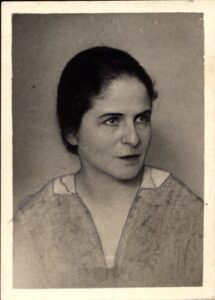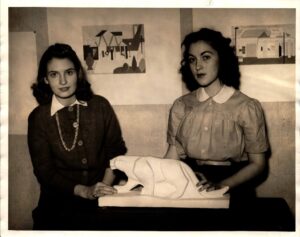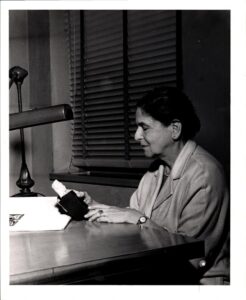Dr. Elisabeth Anna Marie Jastrow was an Associate Professor of Art History at Woman’s College (WC) of the University of North Carolina (now UNC Greensboro) from 1941 until her retirement in 1961. Though she spent the last twenty years of her career teaching art history, her true passion was classical archeology. Elisabeth Jastrow was born October 7, 1890 in Berlin, Germany into a family of intellectuals and developed an early interest in archeology.
Dr. Jastrow was so interested in archeology that she had planned to pursue a career as an archeologist, though she was thwarted at nearly every turn. Jastrow wrote, “My desire always has been to participate in excavations or to make museum work my career, but both these fields were practically closed to women in Germany.” Jastrow worked tirelessly to set herself apart in the field of archeology. She completed her Ph.D. in 1916 as the chaos of World War I was having an impact on all of Europe. Her studies were interrupted in 1914 when she took a break to work as a nurse’s aide in a Red Cross Hospital in Riemenstadt for a year.
Jastrow was a voracious learner; she studied and traveled broadly from 1910 through the remainder of her working life. She studied in Greece, Italy, Germany, Denmark, England, Switzerland, Holland, and once in the United States, she continued to travel and studied in Canada, Cuba, and France. Despite earning a Ph.D., magna cum laude, from the University of Heidelberg, Germany and a specialized certification to make molds of sculptural objects from a sculpture studio in Switzerland, finding meaningful work in archeology was a challenge for her. By the 1930s, she had an impressive resume in research, instruction, and museum cataloging. At times though, she had to make do with working as a German tutor or an elementary teacher, but she did so as she continued her own research.
Perhaps more detrimental to her budding career than being a woman in Germany during the 1930s was the fact that she was of Jewish descent. Her family were culturally assimilated Jews but the German race laws instituted in 1933 would put an end to her academic career in Germany. At that time, Jastrow was finally employed at Akademisches Kunst-Museum, University of Bonn, Germany, as an Assistant and Curator working to prepare and publish a catalogue of a collection of Greek vases, a particular interest of hers. However, the Nazi government withdrew her appointment to the museum and she had to leave Germany to continue her career. Jastrow was awarded the International Fellowship of the American Association of University Women for the year of 1934-1935, which allowed her to continue her archeological research in Italy. In 1937, Jastrow’s father died and she was no longer allowed to return to Germany nor could she take any money out of the country. Her father had remained in Germany with her mother and sister until his death. Jastrow stayed in Italy until the summer of 1938 when she travelled to Switzerland to study mold-making to create reproductions of art objects.
In October 1938, Jastrow first came to the United States on a visitor’s visa where she gave lectures on classical archeology at several prominent universities. A friend of her father’s was a professor at Harvard University and hosted her in Cambridge, Massachusetts for an extended stay. In April 1939, Jastrow was offered a year-long position at Museum of Fine Arts in Boston. At the end of that year, she left the United States for Cuba and soon returned as a non-quota immigrant and began the process of becoming an United States citizen. She spent the next couple of years trying to make a living doing translations and occasionally making sculptured reproductions of art objects for museums or artists. Though she reported a certain degree of success, she acknowledged that it was difficult to find much work in light of the world situation in the late 1930s and early 1940s.
In January of 1941, Elisabeth Jastrow first came to Greensboro to work at Woman’s College as an Instructor in Art History. In June 1941, she was hired as an Assistant Professor of Art History and was promoted to Associate Professor in 1953. She also taught German for her first few years at Woman’s College. Jastrow continued her research and travels during her time in Greensboro and published numerous articles and a couple of books.
Jastrow’s contacts and reputation allowed her to bring several significant exhibitions to the Weatherspoon Art Gallery at Woman’s college, including an exhibition from the Museum of Modern Art and an exhibit of photographs of Egyptian Art belonging to the collection of a colleague in Germany. Though her contributions to the field of archeology were numerous and her impact as an educator well documented, her career was no doubt stifled by her limitations of being both a woman and a German Jew during the first half of the 20th century. Her years in Greensboro were marked by her involvement in various organizations related to history and archeology as well as time with her family as her mother eventually came to live with her.
Dr. Jastrow retired from Woman’s College in 1961 and remained in the Greensboro area until her death at age 91. Her niece and nephew spoke of their aunt at her funeral and described her as a woman of impressive inner strength and discipline as she had pursued a new life and language upon her exile from her native Germany due to “Hitler’s madness in Europe”. Her niece, who called her Aunt Ebith, described her tender relationship with an aunt who had introduced her to the beauties of antiquity and sent postcards from all over the world as she travelled and continued her research despite the chaos of WWI and WWII. Indeed, Dr. Elisabeth Jastrow was a pillar of inner strength and a model of perseverance for the young women of Woman’s College of the University of North Carolina.
By Suzanne Helms


